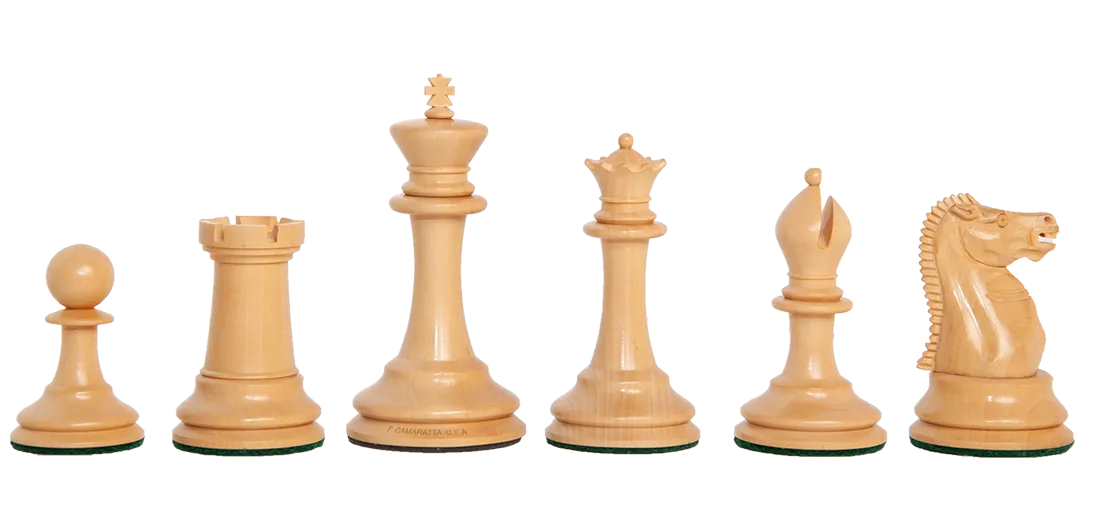Introducing The Steinitz Series Luxury Chess Pieces (3.5") from the Timeless Collection

Offered here is a set of Reproduction Jaques Steinitz Chessmen, Boxwood and Ebony, weighted. The Jaques Steinitz-style Chessmen were originally produced between 1865 and 1870. This faithful reproduction was recreated by noted chess Historian, Frank Camaratta. The Kingside Rooks and Knights are marked on their summits with a red King’s crown. These authentic Staunton chessmen are cushioned atop green baize base pads. This is a very impressive set of chess pieces with masterfully carved “Megamouth” Knights. The King stands 3.5″ tall with a 1.7″ diameter base. This referred to as the “Tournament size”. These Reproduction Chessmen are shipped with an accurate facsimile of the original green manufacturer’s label. This is a set of 34 chessmen, which includes an extra set of Queens to facilitate Pawn promotion, an innovation introduced in 1996 by Frank. These Reproduction Chessmen play and display best on a chessboard with 2-1/8" or 2-1/4" squares.
About Wilhelm Steinitz:
Wilhelm Steinitz (May 17, 1836 – August 12, 1900) was an Austrian/American chess master, and the first undisputed World Chess Champion from 1886 to 1894. Steinitz was born on May 17, 1836, in the Jewish ghetto of Prague. The youngest of a tailor’s thirteen sons, he learned to play chess at age 12. He began playing serious chess in his twenties, after leaving Prague in 1857 to study mathematics in Vienna, at the Vienna Polytechnic.
Steinitz improved rapidly during the late 1850s, progressing from third place in the 1859 Vienna City championship to first in 1861. During this period he had become the strongest player in Austria and was nicknamed “the Austrian Morphy”.
Between 1873 and 1882 Steinitz played no tournaments and only one match (a 7–0 win against Blackburne in 1876). Steinitz returned to competitive chess in the Vienna 1882 chess tournament, which has been described as the strongest chess tournament up to that time. Despite a shaky start he took equal first place with Szymon Winawer, ahead of James Mason, Johannes Zukertort, George Henry Mackenzie, Joseph Blackburne, Berthold Englisch, Louis Paulsen and Mikhail Chigorin. Steinitz was one of the most dominant players in the history of the game. He was unbeaten in match play for 32 years, from 1862 to 1894. Although Steinitz became “world number one” by winning in the all-out attacking style that was common in the 1860s, he unveiled a new positional style of play in 1873. Steinitz lost his title to Emanuel Lasker in 1894, and lost a rematch in 1896–97.
In February 1897, the New York Times prematurely reported his death in a New York mental asylum. Some authors claim that he contracted syphilis, which may have been a cause of the mental breakdowns he suffered in his last years. In the months prior to his death, he spent some time in institutions as a result of his failing mental health. His chess activities had not yielded any great financial rewards and he died a pauper in the Manhattan State Hospital (Ward Island) of a heart attack on August 12, 1900. Steinitz is buried in the Cemetery of the Evergreens in Brooklyn, New York.
